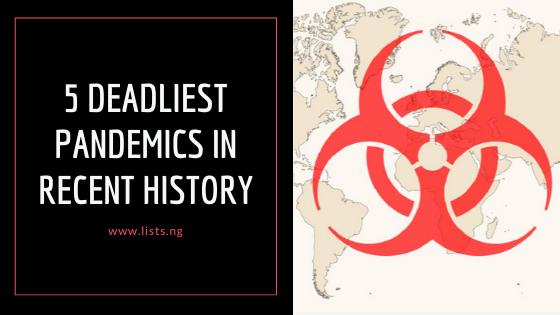A pandemic is when a disease spreads over several countries or continents.It is the highest possible level of a disease. When a communicable disease becomes prominent or wide spread in an area, the chances of it becoming a pandemic rises as humans are constantly moving from one place to another. Throughout there have been pandemic outbreaks like leprosy in the 11th century and the bubonic plague of 1665. With the discovery of new viruses, the world has been hit with fresh pandemics in recent times.
Below are the top 5 deadliest pandemics in recent history
Spanish flu – 1918
The 1918 influenza pandemic, also known as Spanish flu was a pandemic that spread around the world between 1918 and 1919 caused by an H1N1 virus, with an avian (bird) origin. The flu infected an estimated 500 million people around the world, including people living in places as far as remote Pacific Islands and in the Arctic. In terms of death toll, it is reported that the flu ultimately caused least 50 million deaths worldwide, and 25 million of those deaths were recorded in the first 25 weeks of the outbreak.
Asian flu – 1956
The Asian Flu was a pandemic outbreak of H2N2 avian influenza that originated in China in 1956 and rapidly spread worldwide. It spread to Singapore in February 1957, reached Hong Kong by April, and US by June. It originated from a mutation in wild ducks combining with a pre-existing human strain. Between 1957 to 1958, the pandemic caused almost four million deaths between, particularly affecting the elderly.
Hong Kong flu – 1968
The 1968 flu pandemic was a category 2 flu pandemic whose outbreak in 1968 and 1969 killed an estimated one million people worldwide. It was caused by an H3N2 strain of the influenza A virus, descended from H2N2 through antigenic shift. The first record of the outbreak in Hong Kong appeared on 13 July 1968. By September 1968, the flu reached India, the Philippines, northern Australia and Europe. That same month, the virus entered California from returning Vietnam War troops but did not become widespread in the United States until December 1968. It would reach Japan, Africa and South America by 1969.
HIV/AIDS
HIV/AIDS were first discovered in the early 1980s. Today, the virus has become a global pandemic. Sub-Saharan Africa is the region most affected. In 2018, an estimated 61% of new HIV infections occurred in the region. In 2017, approximately 1 million people in the United States had HIV. As of 2018, approximately 37.9 million people are infected with HIV globally and per estimates, the AIDS death toll in Africa alone may reach 90–100 million by 2025.
Swine flu – 2009
The 2009 flu pandemic or swine flu was an influenza pandemic that lasted from early 2009 to late 2010. First described in April 2009, as swine flu, the virus appeared to be a new strain of H1N1 which resulted when a previous triple reassortment of bird, swine and human flu viruses further combined with a Eurasian pig flu virus. It is estimated that 11–21% of the then global population (of about 6.8 billion), or around 700–1400 million people contracted the illness with about 150,000–575,000 fatalities.






